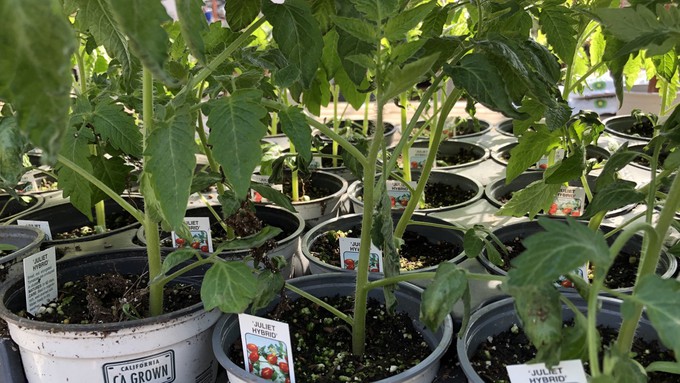
Wait until soil temperature warms to 65 degrees

These Juliet tomatoes are just the right size for planting -- if it were April. As it is, February is too cold, yet the seedlings were already on display for sale this past Wednesday. Kathy Morrison
Is it too early to plant tomatoes? Yes! It’s mid-February and still winter, no matter the daytime air temperature or how much sun. Ignore those tomato seedlings now showing up in nurseries; if planted in the ground now, they’ll only suffer.
But to know for sure about tomato planting time, feel your soil. More specifically, measure its temperature.
Soil thermometers, available at nurseries, are a handy tool that will prevent costly planting mistakes. Know which seeds and tender transplants need soil temperature-wise before condemning them to a frosty demise.
Right now, our soil is too cold for even cool-season crops to get comfortable. According to UC Davis’ weather stations, soil temperature at its Russell Ranch test site on Friday afternoon (Feb. 17) was 46.3 degrees, measured about 8 inches below the surface; 46.5 degrees about 4 inches down. Cool-season vegetables such as beets and lettuce need 50-degree soil for root development and growth. When soil is too cold, the seed can rot before it sprouts.
Tomatoes, peppers and other summer crops require soil at least 60 degrees to get started; they’ll still just sit there and not really grow, but at least their roots won’t feel like they’re freezing. To get off to a strong start, tomatoes prefer at least 65-degree soil when transplanted.
And that’s almost 20 degrees warmer than our soil is now.
When will our soil reach 65 degrees? Most likely in mid to late April, our traditional tomato planting time.
In the meantime, if you've already succumbed to the lure of those tomato seedlings, any plants that look ready to go into the ground can be transplanted into 1-gallon black plastic pots. Line the pots with several sheets of newspaper for extra warmth and insulation before filling with potting mix. The black plastic will absorb heat and help root development inside the pot – while our native soil remains cold for several more weeks.
In their cozy black pots, baby tomato plants can grow strong and develop a sturdy rootball. Once their future planting bed warms up into the 60s, transplant the seedlings – with rootballs intact – into their summer homes.
For a look at UC Davis’ weather station reports and soil temperature: https://atm.ucdavis.edu/weather/uc-davis-weather-climate-station/.
Comments
0 comments have been posted.Sacramento Digs Gardening to your inbox.
Sites We Like
Garden Checklist for week of July 21
Your garden needs you!
* Keep your vegetable garden watered, mulched and weeded. Water before 8 a.m. to reduce the chance of fungal infection and to conserve moisture.
* Feed vegetable plants bone meal, rock phosphate or other fertilizers high in phosphate to stimulate more blooms and fruiting. (But wait until daily high temperatures drop out of the 100s.)
* Don’t let tomatoes wilt or dry out completely. Give tomatoes a deep watering two to three times a week.
* Harvest vegetables promptly to encourage plants to produce more. Squash especially tends to grow rapidly in hot weather. Keep an eye on zucchini.
* Pinch back chrysanthemums for bushy plants and more flowers in September.
* Remove spent flowers from roses, daylilies and other bloomers as they finish flowering.
* Pinch off blooms from basil so the plant will grow more leaves.
* Cut back lavender after flowering to promote a second bloom.
* It's not too late to add a splash of color. Plant petunias, snapdragons, zinnias and marigolds.
* From seed, plant corn, pumpkins, radishes, winter squash and sunflowers.